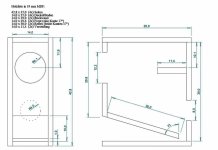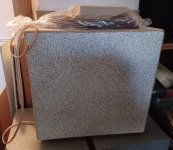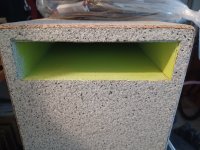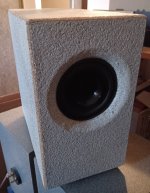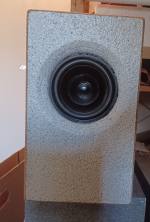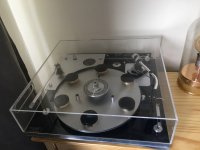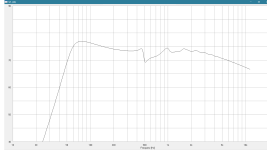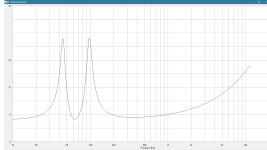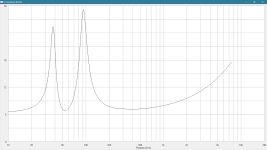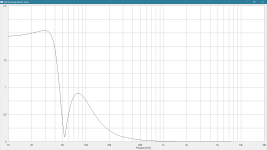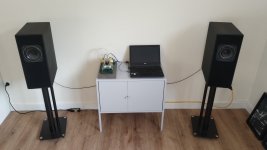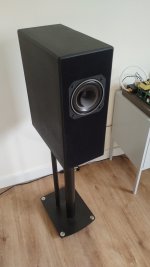Hello,
which case would you build for the Monacor SPH-60X?
https://www.monacor.com/products/components/speaker-technology/hi-fi-full-range-speakers-/sph-60x/
I can't decide between these two cases:
http://www.hornlautsprecher.de/projekt_alpha.htm
https://www.acoustic-design-magazin.de/2017/10/14/ct-193-die-fast-vergessene-legende/
Can anyone simulate the two cases or give me some advice?
Thank you very much.
which case would you build for the Monacor SPH-60X?
https://www.monacor.com/products/components/speaker-technology/hi-fi-full-range-speakers-/sph-60x/
I can't decide between these two cases:
http://www.hornlautsprecher.de/projekt_alpha.htm
https://www.acoustic-design-magazin.de/2017/10/14/ct-193-die-fast-vergessene-legende/
Can anyone simulate the two cases or give me some advice?
Thank you very much.
Attachments
They are probably very similar bass reflex enclosures, the "horn" is just a tapered reflex port. I would not build any of both but try to make a flared port mass loaded "transmission line" (or a simple bass reflex box) with the port at the back of the enclosure.Can anyone simulate the two cases or give me some advice?
Look here: https://www.diyaudio.com/community/...rbers-and-port-geometries.388264/post-7695049
Edit: Why would you need another simulation? The first example includes a simulation graph and the second even a measured response graph!
Last edited:
Hello Bronkowitz,
more than seven years ago I installed exactly this full range driver in the Udo W. proposal. Like you, I was also flirting with the Alpha suggestion, and I was also thinking about a horn or a TML. After endless simulations with the most popular German programme AJDorn, I simply made a decision: that's all you can do with this fun loudspeaker. To cut a long story short: I widened the baffle, moved the port to the rear, glued in an angled reflection board and coupled the driver to the resonator without any huge offset. Everything worked perfectly, but in the end the sound was extremely disappointing. The RLC blocking circuit is not sufficient to make the frequency response tolerable. From 200Hz to 4kHz you have to reduce the SPL considerably. Between 4 and 5kHz you have a huge resonance peak, above 10kHz an absolute catastrophe.
A combination of parallel resonant circuit and series resonant circuit passively pulls down the entire midrange and levels everything out so that you can then actively equalise.
Actively corrected everywhere, this little speaker is amazing, really good. But now also completely without efficiency. The rear port, which is unfortunately equivalent to an additional midrange horn, does what it is supposed to do as a BR sufficiently well, and the additional information it throws backwards from 300Hz to 2kHz fills the room with ...
With marvellous phantom sound sources!
Without an acoustic measurement system (I've been using CLIO for eons), this driver will drive you crazy. Unfortunately, this concept only achieves a usable frequency response with active equalisation. And since some of the corrections are very massive ...
HBt.
PS
I was pretty disappointed, but if you actively equalise, then it's really cool. The horn reflex thingy belongs at the back.
more than seven years ago I installed exactly this full range driver in the Udo W. proposal. Like you, I was also flirting with the Alpha suggestion, and I was also thinking about a horn or a TML. After endless simulations with the most popular German programme AJDorn, I simply made a decision: that's all you can do with this fun loudspeaker. To cut a long story short: I widened the baffle, moved the port to the rear, glued in an angled reflection board and coupled the driver to the resonator without any huge offset. Everything worked perfectly, but in the end the sound was extremely disappointing. The RLC blocking circuit is not sufficient to make the frequency response tolerable. From 200Hz to 4kHz you have to reduce the SPL considerably. Between 4 and 5kHz you have a huge resonance peak, above 10kHz an absolute catastrophe.
A combination of parallel resonant circuit and series resonant circuit passively pulls down the entire midrange and levels everything out so that you can then actively equalise.
Actively corrected everywhere, this little speaker is amazing, really good. But now also completely without efficiency. The rear port, which is unfortunately equivalent to an additional midrange horn, does what it is supposed to do as a BR sufficiently well, and the additional information it throws backwards from 300Hz to 2kHz fills the room with ...
With marvellous phantom sound sources!
Without an acoustic measurement system (I've been using CLIO for eons), this driver will drive you crazy. Unfortunately, this concept only achieves a usable frequency response with active equalisation. And since some of the corrections are very massive ...
HBt.
PS
I was pretty disappointed, but if you actively equalise, then it's really cool. The horn reflex thingy belongs at the back.
A few details about my housing (I have found all my records in the meantime):
Width inside
16cm
Height inside
29,3cm
Depth inside
31,6cm
The BR board is 28.4cm long, the reflector 16*16cm, AH 25.6cm^2 & AM 64cm^2. The port is at the top and directly opposite the driver.
For a photo I have to go down to the basement.
Width inside
16cm
Height inside
29,3cm
Depth inside
31,6cm
The BR board is 28.4cm long, the reflector 16*16cm, AH 25.6cm^2 & AM 64cm^2. The port is at the top and directly opposite the driver.
For a photo I have to go down to the basement.
The
- front may still be missing a veneer (like a waveguide), but I never got around to printing it. The membrane has been coated several times with Visaton's LTSxx coating
- housing is a lightweight construction, poplar multiplex with cork and PU coating
- reflection board inside is at a 60° angle, all the inner surfaces are covered with Visatons white insulating/ damping material ..!
Attachments
Hello hbtaudio,Hello Bronkowitz,
more than seven years ago I installed exactly this full range driver in the Udo W. proposal. Like you, I was also flirting with the Alpha suggestion, and I was also thinking about a horn or a TML. After endless simulations with the most popular German programme AJDorn, I simply made a decision: that's all you can do with this fun loudspeaker.
does that mean you simulated different enclosures and CT193 was the best? That answers my question...
Sadly, the SPH-60X seemed to change a few years ago, or at least the units I tried seemed to differ, suggesting there was a shift in the batch. Still reasonably-reasonable though. Be that as it may, it was about the nearest thing I came across to the long-defunct and much-missed 40-1354, and worked rather well in the 'original' BIB enclosure that provided some of the baseline for the nominal created for subsequent types. There's plenty you can do with it if you feel so-inclined: it's a drive unit, like any other. That was my favourite load with it anyway, although I'm slightly biased as GM and I were probably the main culprits at keeping it in the wider eye after Terry passed away in '05, and a bookshelf it ain't, so if that's what you're after, a 6ft tall Voigt-style pipe-horn probably isn't going to be ideal. That said, I rammed a pair into the corners of a bedroom for many years and they were surprisingly unobtrusive, even with my lousy veneering.
I usually use a smartfone EQ to adjust the sound.
So this EQ is for free.
Just build the enclosure you consider appropriate.
If you want more efficiency just use some corner placement with the reflex port pointing directly to the corner.
The rest is EQ by ear.
Here a 20cm omni corner placed
So this EQ is for free.
Just build the enclosure you consider appropriate.
If you want more efficiency just use some corner placement with the reflex port pointing directly to the corner.
The rest is EQ by ear.
Here a 20cm omni corner placed
in a nutshell:does that mean you simulated different enclosures and CT193 was the best? That answers my question...
it's all about an environment (the cabinet) for the drilled-out SPH60X midrange driver, which you would like to see as a bass-midrange driver and, with its additional twist cone, as a full-range driver. Nothing more and nothing less.
Udo W.'s and Heinz S.'s quick suggestion from the 01/2001 issue of K&T provides a 13-liter air cushion and the Alpha of the “Hornfreunde” also uses this volume (this mass), both resonator incarnations are tuned to approximately 54Hz.
Now you have to decide for yourself what all these equivalent high pass filters (the bass reflex enclosure) should look like.
Of course, I have not only simulated these two suggestions, but have also carried out countless electrical and acoustic measurements.
#
The Alpha looks much more appealing than the “horn reflex resonator” with its later slightly adapted resonator geometry.
As a result, both implementations are actually quite close to each other, i.e. if you want a nice front with a visible port, build the Alpha with the “later” 45° opening of the mouth.
my TSP:
Rdc = 6.33Ohm
Cms = 0.907 [mm/N]
Mms = 5.54g (5.47g)
Rms = 0.88 [kg/s]
BL = 4,73 [N/A, Tm]
Qts = 0,56
Qes = 0,7
Qms = 2,8
Vas = 8ltr
fs_o = 71Hz
Sd approx 78.86 cm^2
Xmax = +/-1.3mm
#
All measurements match the simualtions! Acoustically, they are even strikingly similar to Udo W.'s releases.
Build the Alpha:
AH 25.2cm^2
AM 64.8cm^2 final enlarged to 144cm^2
l_horn_resonator approx 30cm.
Why?
Because then we can compare both concepts, also in terms of measurement, if you lends them to me.
👍They are probably very similar bass reflex enclosures, the "horn" is just a tapered reflex port. I would not build any of both but try to make a flared port mass loaded "transmission line" (or a simple bass reflex box) with the port at the back of the enclosure.
Look here: https://www.diyaudio.com/community/...rbers-and-port-geometries.388264/post-7695049
Edit: Why would you need another simulation? The first example includes a simulation graph and the second even a measured response graph!
"stv" has actually already said everything in the first follow-up posting.
Or a simple TML:
22 ltr.
length 106cm
AH 260cm^2
AM 160cm^2
fill completely and easily.
31 ltr.
AH 370cm^2
AM 230cm^2
also 106cm physical length ...
fill completely loose.
Or classically a real BR:
Vbox = 21.5 ltr
fb = 52.4Hz
!
But simply let your own ideas come true. Enjoy building.
HBt.
Of course, the downside to this may be if you regularly use one of these as a source & don't have any way of realistically inserting additional ADC - DAC stages into the chain. 😉I usually use a smartfone EQ to adjust the sound.
So this EQ is for free.
Just build the enclosure you consider appropriate.
Attachments
One more thing
For the complete active EQ of this full-range concept, the correction range is up to 16dB, which is already quite a lot in terms of performance / power, so if you don't want to actively equalize, then prepare yourself for a disappointment or, as they say today:
a challenge!
For the complete active EQ of this full-range concept, the correction range is up to 16dB, which is already quite a lot in terms of performance / power, so if you don't want to actively equalize, then prepare yourself for a disappointment or, as they say today:
a challenge!
Full agreement,Sadly, the SPH-60X seemed to change a few years ago, or at least the units I tried seemed to differ, suggesting there was a shift in the batch. Still reasonably-reasonable though. Be that as it may, it was about the nearest thing I came across to the long-defunct and much-missed 40-1354, and worked rather well in the 'original' BIB enclosure that provided some of the baseline for the nominal created for subsequent types.
the driver data / chassis parameter -set was actually different in the past.
current simulation of the Alpha, with my TSP, high-resolutionCan anyone simulate the two cases or give me some advice?
the housing is very loose and completely filled (use absorbent cotton)
Attachments
If you find it helpful for your impending decision, then “sehr gerne”.Can anyone simulate the two cases or give me some advice?
Thank you very much.
Attachments
i made the KORNETT, with the Monacor as an invers back driver in a double horn
http://www.hm-moreart.de/99.htm

http://www.hm-moreart.de/99.htm
Sehr gerne! 🙂Please report on your building project and the progress, I am interested.
I built the CT193 a while ago, but moved the vent to the rear for aesthetic reasons. Since I didn't trust myself to paint it properly, I coated the case with automotive underbody protection, and the front panel is covered with velvet film.
I recently found the Alpha and am wondering if it's worth building a new case...
Attachments
Well,
there's not much you can say now. It looks very successful - and the port is at the back, the reflections of the nearby room walls certainly (will be) result in an interesting, virtual acoustic 3D sound image.
@hm,
What do you think about combining the Alphorn with the current SPH60X ?
Or a frugal
also only one type of a bass reflex system, I thing.
HBt.
there's not much you can say now. It looks very successful - and the port is at the back, the reflections of the nearby room walls certainly (will be) result in an interesting, virtual acoustic 3D sound image.
@hm,
What do you think about combining the Alphorn with the current SPH60X ?
Or a frugal
also only one type of a bass reflex system, I thing.
HBt.
A clear answer, it would only be worthwhile if you want to have a second pair of speakers with this driver. I can only advise: to actively equalize your system, “you only believe it when you have heard it yourself”, of the entire spectrum.I recently found the Alpha and am wondering if it's worth building a new case...
- Home
- Loudspeakers
- Full Range
- Enclosure for Monacor SPH-60x
